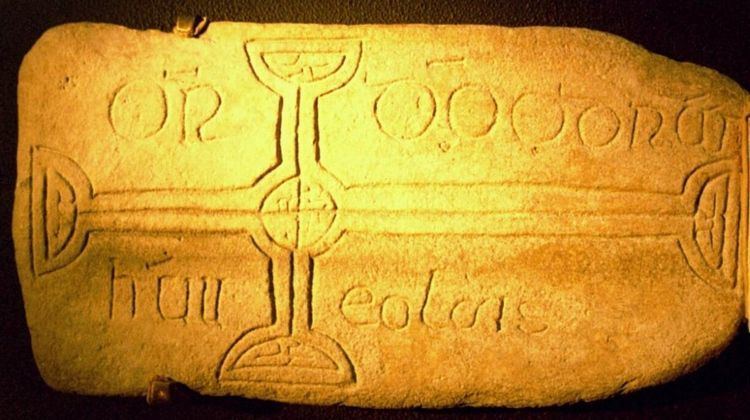Education Monasticism, Letters | Occupation Scribe | |
 | ||
Born 10th century Muintir Eolais Home town Muintir Eolais, County Leitrim IE Relatives Eolais Mac Biobhsach (grandfather?) Died Clonmacnoise, Republic of Ireland | ||
Odhran Ua hEolais (Irish: Ódhrán, Odhrán, Odrán, Odráin, pron. "Orin", dim. of Odar 'gray', or "pale" anglicised "Horan", and Irish: hEolais family name is still used today, anglicized as "Olus", died A.D. 994), was a medieval scribe and scholar at the abbey of Clonmacnoise. He must have been born, and lived his childhood, in the kingdom of Conmaicne Réin, which corresponds to present day south county Leitrim. We do not know any significant details of his personal life, but Odhran moved to county Offaly in adult life, to become Lector and a famous scriba of Clonmacnoise. His death is recorded in the Annals of the Four Masters. A cross-stone of Odhran, with his name inscription legible in middle Irish, is preserved to this day.
Contents
Life
Odhran was born into the Túath called Conmaicne Réin, present day south county Leitrim, sometime in the first half of the 10th century. His family a Gaelic dynasty who ruled it, and Odhran was probably grandson of Eolais Mac Biobhsach (Irish: Ua h-Eolais, "descendant of Eolais"), a king "Conmaicne Réin". He received some sort of formal education probably at the Fenagh, Mohill, or Cloone monastery in county Leitrim. He became proficient and literate in Irish language, Latin, bardic tradtion, and religious doctrine.
Sometime in his adult life he moved to Clonmacnoise, the celebrated early Irish Christian monastery, taking the position of ecclesiastical Lector and "scribe of Clonmacnoise". Odhran belonged to the scholarly hierarchy of the church, otherwise called "Irish: gráda ecnai", implying he was not in orders but rather trained in Christian learning. Odhran probably shared duties for scribing manuscripts, and his contributions if preserved over the centuries, would exist in the Irish Annals.
Odhran may have moved to Clonmacnoise to help secure burial rights in Clonmacnoise for Mag Raghnaill of Conmaicne Réin. There was an alleged controversy between Fearghal Ua Ruairc, King of Connaught (died A.D. 964 ), and Brian mag Raghnaill, a successor of Eolais mac Biobhsach. Mag Raghnaill complained he had no place for a tomb at Clonmacnoise, unlike Fearghal Ua Ruairc, and so bestowed "48 ploughs" of Kiltoghert land to the bishop of Clonmacnoise in exchange for a burial right. It is tempting to suppose the appearance of Odhran Ua hEolais, an outsider, at Clonmacnoise is related to such matters if true, but O'Donovan raises doubts about this O'Rourke connection.
Death
The death of Odhran, c. A.D. 994, is recorded in the Annals of the Four Masters as follows:
Cross-slab
His cross-slab has been preserved, and four different sources interpreted the inscription as follows:
Instead of the more usual key-pattern, interlace and channels were used to ornament the central and boundary areas of the distorted cross motif on Ordan's stone, a decorative practice which dropped out of use on Clonmacnoise grave-slabs, c. AD 1000. The cross on the "Ódhrán stone", a poor piece of work, may be regarded as an imitation of the design on the handsome stone of "Mael-Finnia", the Abbot of Clonmacnoise who died A.D. 991, as both stones share similar ornamental features. These stones may be "grave stones". However, the awkward way in which the inscription was fitted on to the stone introduces the notion these slabs were kept in stock in the monastery workshop with pre-inscribed crosses, until a client name needed to be fitted in. This suggests Ódhrán commissioned the stone to request prayers for himself, implying the stone is not a grave memorial.
O'Donovan claimed this family name, (Irish: Ó hEóluis "descendent of Eolais"), can be found today anglicized as "Olus" or "Olis", though the surname is rare.
